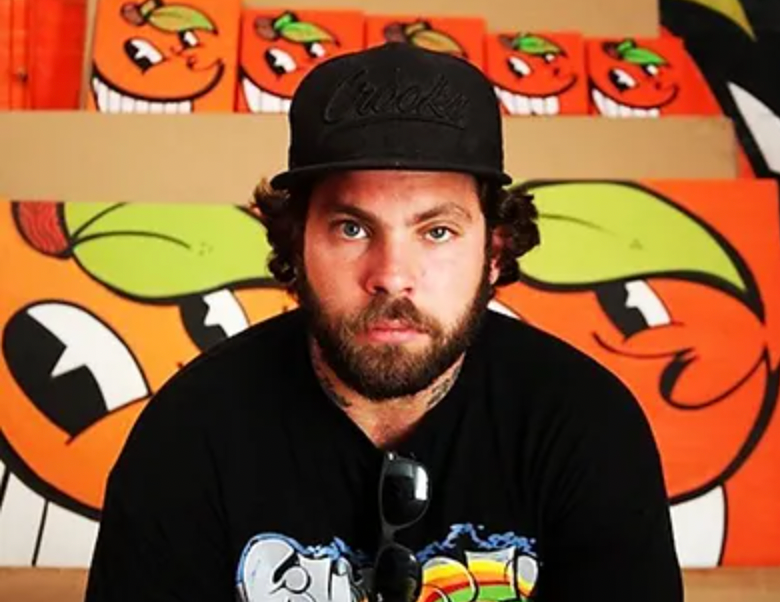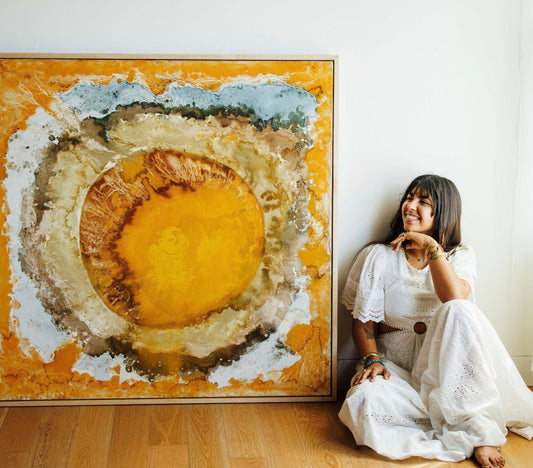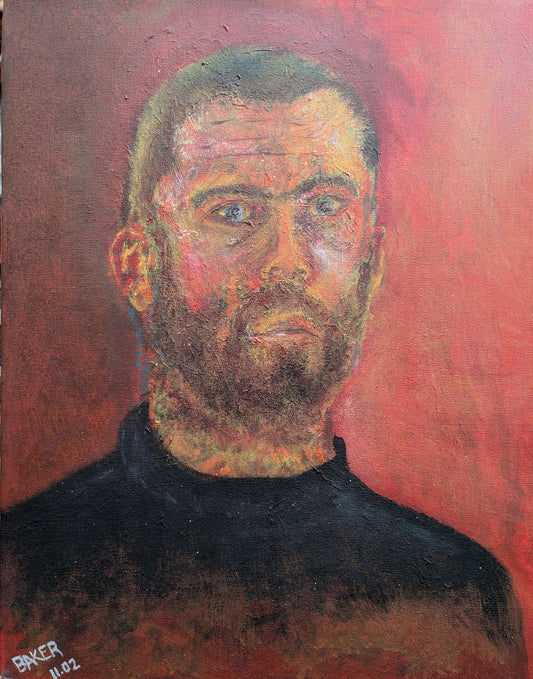Who is ATOMIK?
Adam Vargas greeted me with a bearded grin and a fist bump as he opened the gate to his Miami Style Gallery located at 47 NE 25th St in Wynwood, Miami. The born-and-raised Miami artist, better known as ATOMIK, is behind the iconic orange character, which has become a symbol for his city. Before the famous and accredited Miami-based artist gained international recognition for his graffiti and street art, he was just a teen with a love for art and the constant need for activity.

As we sat across from each other under the South Floridian heat masked by wind and overhead air traffic, he reminisced on his initial attraction to graffiti art. “I was always running around, climbing on stuff,” which perfectly matched the nature of the genre, where “you can climb something and put your name,” he said.
ATOMIK’s roots are in Miami, but also in drawing and tagging. “I didn’t necessarily have a style before I started painting graffiti,” he remembers.
“It wasn’t until my friend Jimmy went to Columbia and left some paint behind a corner store, Circle K” as he pointed across the street to where the convenience store used to be. “I used his paint, borrowed his paint, and did a piece behind the store. That was my first time spray painting."


For readers who are not familiar with the term “tagging,” it equates with a traditional artists’ signature, and is defined by Wide Walls as “a stylized personal signature and contains graffiti writer's name, also known as a moniker."
After his first encounter using spray paint, he experimented again in his own neighborhood around ‘94, where he tagged “FRESH” on a palm tree entering his town-home complex. “I remember my friends’ parents telling me ‘don’t ever write on trees again.’” ATOMIK obeyed, and went on to use markers and spray paint on abandoned buildings as his medium.
It is important to note the difference between graffiti art and street art. While ATOMIK’s career began with spray paint and graffiti, he now characterizes it as street art because “it is just a character, it's not the name and it's not the crews, it’s just an image.”
He has experimented with several other materials when working on high scale projects. The artist reminisced about a project he completed during the Roller Derby on Second Avenue across from Wynwood Life, when a Houston-based friend donated 100 gallons of orange bucket paint to him.
“Instead of using spray paint, I was using roller paint,” he explained, “that’s when I started getting the eight foot long arm that multiplies into two more, that then multiplies into 24 feet just standing on the ground. That was one of those spots where I was like, ‘damn these things are gigantic and they’re right there on street level.” ATOMIK is also a prominent member of the talented graffiti artist group Miami Street Graffiti, also “MSG,” joining 7-10 years after the collective was founded.


Behind the Orange
The destruction of the Orange Bowl in 2008 gave birth to ATOMIK’s orange character. The nameless icon began as a replica to the Orange Bowl’s mascot Obie, but a loose cease and desist allowed for ATOMIK to individualize and characterize the figure as a tag of his own.
The orange doesn’t represent a certain thing, but rather is ATOMIK’s counterpart, and with that comes constant evolution. “It started with the Orange Bowl, but now it’s more of a personal thing, like my own brand or image or name…like a logo,” he said, “It represents me and my city, and my family, and my friends.”
ATOMIK's early career was influenced by local inspirations, alongside what he saw in books and magazines, as he recalls imitating what he saw in subway art and spray can art in the 80's.
He now uses that concept, but with his own character, saying, “I don’t put any emotion into my pieces…I’m just a robot. All I do is copy and paste, and just as I put my name everywhere, I put my character everywhere.”
Despite admitting that he doesn’t put his own direct emotions into his work, he does use several different characteristics in his orange that evokes emotion from fans and on-lookers. The orange has a permanent smile, which of course resembles happiness and joy. But there are countless variations including color, scale, body, and namely the teardrop.
From the demolition of the orange bowl, the tear initially represented “a tattoo tear, but that’s a little extreme,” he said, “so now I do the teardrop only in white, so it could be a sweat drop, or a teardrop, or just open water droplets.”

ATOMIK In Action
With ATOMIK’s fast-paced career, neither him nor his orange are static, but the nature of the street art genre puts them at risk of several things. First, there is an extremely high likelihood that one’s work can be almost immediately destroyed. Coincidentally, the innate aspects of graffiti being painted over or even intentionally defaced, mirrors why and how ATOMIK’s orange came to be.
“You put your time and effort and money into a piece and it gets crossed off the next day, you’re kind of like, ‘this sucks.’ But you’re almost immune to it as a graffiti writer because it’s the roll of the dice.”
There is no question that ATOMIK has worked with an abundance of dangerous and unlikely surfaces, from dismantled wooden walls to trains to water towers, as he prefers a rugged surface to a blank wall. Not only can his work be destroyed, but next comes the risk of physical injury at extreme levels.
One of his scariest moments occurred in Hong Kong while painting a billboard. He vividly recalls climbing up the billboard with ease, but on the way down, one of the ladder legs had been rusted out and was ready to go down while ATOMIK was 30 feet up in the air. He also conquered the Chicago Water Tower, which is just over 182 feet tall, for which the climb to the base was a mission in itself, but the small platform at the top had little structure and support.
With the potential of his work being maimed and the threat of physical injury, ATOMIK’s global canvas also comes along with a world-wide list of innate legal risks. Of course, when one paints somewhere without permission, there is potentially arrest and jail-time. That being said, ATOMIK doesn’t necessarily paint with permission.
With all of his travels, ATOMIK went on to share his own past with the law locally and internationally. “If you get arrested for any crime in Tokyo, you’re sitting in jail for 21 days before you even see the judge in that county,” he explained. “I used to go in and out of jail a lot when I was growing up,” he continued, “there’s been multiple cities and countries that I’ve been unfortunately caught. And you deal with it…it’s a roll of the dice.”
ATOMIK mentioned graffiti.org, where they post and credit “art crimes,” where he is featured several times. Despite the legal aspects and the levels of severity, he simply does it for the thrill and the fun of the painting. That is the beauty of art and the creator’s talent, for which a true artist will go to any and all extreme lengths to be happy with their work.

What's Next
Aside from Adam’s successful graffiti and street art career, he has several extremely popular products on the market. Hats, tee-shirts, screenprints, rugs, and sculptures are sold out. While he restocks, it is obvious for us to wonder what else is in store. Well don’t worry, over the course of our time together, ATOMIK put together a bucket list. From eight-inch to six-foot sculptures, he also desires to work on skyscrapers, planes, helicopters, larger murals, and anything above his already accomplished height of three stories.
As we wrapped up our interview, I thanked the famous street artist for his time. He led me from the outdoor back area where we had sat for an hour and a half and through his incredible gallery. With a toothy, bearded smile, Adam held out his fist and I returned it with mine in a mutual bump, just as we had when I walked in. But instead, I was walking out with an incredible experience and a rich understanding of the legendary artist ATOMIK.
©ArtRKL™️ LLC 2021-2023. All rights reserved. This material may not be published, broadcast, rewritten or redistributed. ArtRKL™️ and its underscore design indicate trademarks of ArtRKL™️ LLC and its subsidiaries.





